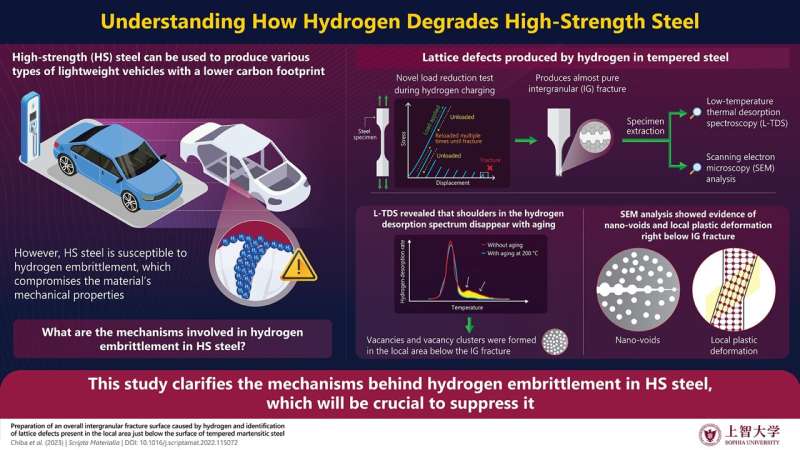
One of the many ways to reduce the energy required for transportation is to make vehicles lighter. High-strength (HS) steel is perfect candidate materials for this purpose, as its higher weight-to-strength ratio allows for the use of less metal to achieve a similar structural integrity. Many automobile companies believe HS steel will be an essential component of various types of cars in the future. However, for this to become a reality, there is a glaring problem that needs to be solved.
When HS steel is exposed to rainwater (H2O) or hydrogen, a phenomenon known as hydrogen embrittlement occurs. Hydrogen atoms diffuse into the lattice structure of the material and progressively weaken it, making it more prone to failure under mechanical stress. Scientists have observed that hydrogen embrittlement in HS steel often leads to intergranular (IG) fractures, which occur along the grain boundaries of the crystalline lattice. Unfortunately, the underlying mechanisms behind this particular type of fracture are difficult to study in isolation in HS steel because other types of fracture tend to occur alongside it.
Against this backdrop, a research team including Professor Kenichi Takai from Sophia University, Japan, recently conducted a study to address this problem. Thanks to an ingenious alternative to the conventional tensile tests used to assess the mechanical properties of materials, they managed to produce almost-pure IG fractures on embrittled HS steel samples. In turn, this enabled them to study these fractures with unprecedented detail. The study, which was co-authored by Dr. Takahiro Chiba of Graduate School of Sophia University (now at Nippon Steel Corporation), was published in Scripta Materialia on January 15, 2023.
In conventional tensile tests for metals, a dog-bone-shaped sample is put under increasing tension until it breaks. As stated above, this causes multiple types of fracture besides IG fractures, such as quasi-cleave fractures, dimples, and shear lips. To prevent this, the researchers came up with an original mechanical test involving repeated loading and unloading of the sample during hydrogen charging. “Our load reduction test was designed to progressively reduce the material’s ultimate tensile strength (UTS). We achieved this by repeatedly removing the load applied to the specimen immediately after the tensile stress reached the UTS under hydrogen charging and the re-applying it,” explains Prof. Takai.
As confirmed by scanning electron microscopy (SEM) images, the proposed load reduction test successfully produced pure IG fractures. The team believes this happens because, after each unloading step, hydrogen atoms are given enough time to fill up the new cracks generated in the material to keep advancing the fracture exclusively along the grain boundaries.
To gain insight into the lattice defects present right below the fracture, the researchers carefully extracted small pieces of the broken sample very close to the fracture surface and used them for lower-temperature thermal desorption spectroscopy (L-TDS). This technique involves observing the rate of desorption of a gas (hydrogen, in this case) from the material at different temperatures, which in turn provides information about the number and types of defects present in it. “L-TDS enabled us to distinguish hydrogen trapping sites on the atomic scale,” remarks Prof. Takai, “Obtaining such basic knowledge about the lattice defects formed in the local area just below an IG fracture surface will provide important clues to understand and potentially suppress hydrogen embrittlement in HS steel.”
In a final set of experiments, the team performed various analyses on SEM images to determine whether the formation of the vacancies and vacancy clusters observed via L-TDS involved plasticity. These analyses revealed that some vacancies coalesced into nano-voids, and that the martensite laths and blocks in the regions around these voids were heavily distorted and difficult to tell apart. This suggests that local plastic deformation occurs right below the IG fracture caused by hydrogen embrittlement.
Overall, the findings of this study will help materials scientists understand hydrogen embrittlement in HS steel better. The findings could pave the way to new methods to suppress it and enable the safe use of HS steel in hydrogen-powered vehicles.
More information:
Takahiro Chiba et al, Preparation of an overall intergranular fracture surface caused by hydrogen and identification of lattice defects present in the local area just below the surface of tempered martensitic steel, Scripta Materialia (2022). DOI: 10.1016/j.scriptamat.2022.115072
Provided by
Sophia University
Citation:
Revealing the nature of fractures in high-strength steel caused by hydrogen (2023, March 29)
retrieved 29 March 2023
from https://techxplore.com/news/2023-03-revealing-nature-fractures-high-strength-steel.html
This document is subject to copyright. Apart from any fair dealing for the purpose of private study or research, no
part may be reproduced without the written permission. The content is provided for information purposes only.
Stay connected with us on social media platform for instant update click here to join our Twitter, & Facebook
We are now on Telegram. Click here to join our channel (@TechiUpdate) and stay updated with the latest Technology headlines.
For all the latest Technology News Click Here
For the latest news and updates, follow us on Google News.
